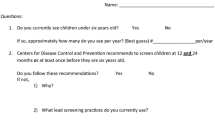Abstract
Objectives
Despite the importance of screening in efforts to address lead poisoning, many children in the United States have never been tested for lead, even when required to receive blood lead testing by state and federal healthcare policy. Fewer children gain access to follow-up or confirmatory testing when elevated blood lead levels are detected.
Methods
In response to previous research that illustrates the extent to which follow-up treatment services have been underutilized and poorly coordinated, this retrospective cohort study examines follow-up testing trends for lead poisoning among Medicaid-enrolled children 6 years and younger in Flint, Michigan, between 2013 and 2015.
Results
These findings illustrate that compliance with follow-up testing procedures was less than adequate during the period of study.
Conclusion
As illustrated in this bivariate analysis, subpopulations in Flint most likely to have lead poisoning were least likely to receive follow-up testing. Evidence also demonstrates that the likelihood that children with lead poisoning received follow-up testing was overwhelmingly associated with their blood lead concentration level than other indicators including socioeconomic status in this high-risk environment.


Similar content being viewed by others
References
American Academy of Pediatrics. (AAP). Lead exposure in children: prevention, Detection, and Management. Pediatrics. 2005;116:1036–46.
Centers for Disease Control and Prevention. 2012. Low Level Lead Exposure Harms Children: A Renewed Call for Primary Prevention. Report of the Advisory Committee on Childhood Lead Poisoning Prevention of the Centers for Disease Control and Prevention January 4, 2012. https://www.cdc.gov/nceh/lead/ACCLPP/Final_Document_030712.pdf Accessed Sept 10, 2019.
Kemper AR, Cohn LM, Fant KE, Dombkowski KJ, Hudson SR. Follow-up testing among children with elevated screening blood lead levels. JAMA. 2005;293(18):2232–7.
Aoki Y, Brody DJ. WIC participation and blood lead levels among children 1-5 years: 2007–2014. Environ Health Perspect. 2018;126(6):1–6.
Dignam T, Evens A, Eduardo E, Ramirez S, Caldwell K, Kilpatrick N, et al. High-intensity targeted screening for elevated blood lead levels among children in 2 inner-city Chicago communities. Am J Public Health. 2004;94(11):1945–51.
Advisory Committee on Childhood Lead Poisoning Prevention (ACCLPP). 2000. Recommendations for Blood Lead Screening of Young Children Enrolled in Medicaid: Targeting a Group at High Risk. https://www.cdc.gov/mmwr/preview/mmwrhtml/rr4914a1.htm Accessed Mar 28, 2018.
Centers for Disease Control and Prevention. 2017. Lead. Centers for Disease Control and Prevention. Retrieved March 4, 2018 (https://www.cdc.gov/nceh/lead/acclpp/actions_blls.html).
Dickman, J. 2017. Children at risk: gaps in state lead screening policies. Safer Chemicals. Retrieved (http://saferchemicals.org/sc/wpcontent/uploads/2017/01/saferchemicals.org_children-at-risk-report.pdf).
Centers for Disease Control and Prevention. 2013. Blood lead levels in children aged 1–5 years: United States, 1999–2010. Morbidity and Mortality Weekly Report. Retrieved from http://www.cdc.gov/ mmwr/preview/mmwrhtml/mm6213a3.htm?s_cid=mm6213a3_e.
General Account Office. 1999. “Lead poisoning: federal health care programs are not effectively reaching at-risk children.” GAO/HEHS-99-18. https://www.govinfo.gov/content/pkg/GAOREPORTS-HEHS-99-18/html/GAOREPORTS-HEHS-99-18.htm, Accessed February 27, 2020.
Markowitz ME, Clemente I, Rosen JF. Screening for lead poisoning: is there follow-up? Am J Public Health. 1999;89:1088–90.
Michigan childhood lead poisoning prevention and control Commission Annual Report 2007: 28.
Highsmith AR. Demolition means Progress: Flint, Michigan, and the fate of the American Metropolis. Chicago: University of Chicago Press; 2015.
Clark A. The Poisoned City: Flint’s Water and the American Urban Tragedy. New York: Metropolitan Books; 2018.
Hanna-Attisha M, LaChance J, Sadler RC, Champney Schnepp A. Elevated blood lead levels in children associated with the Flint drinking water crisis: a spatial analysis of risk and public health response. Am J Public Health. 2016;106(2):283–90.
Robbins, Rebecca. 2017. “CDC panel urges new guidelines for diagnosing high lead levels in children.” January 20, 2017, STAT, https://wwwstatnewscom/2017/01/20/cdc-lead-children/ Accessed Jan 3, 2018.
Michigan Department of Health and Human Services. (2019). Medicaid Provider Manual. MDHHS. Medicaid Provider Manual. (2018). http://www.mdch.state.mi.us/dch-medicaid/manuals/MedicaidProviderManual.pdf Accessed August 1, 2018. Michigan Department of Health and Human Services (MDHHS). (2015). Blood Lead Level Quick Reference for Primary Care Providers. Retrieved March 4, 2018 (https://www.michigan.gov/documents/deq/ProviderQuickReference_Sept2015_501831_7.pdf).
Rosencrants, Troy, Matt McCloskey and Sara McDonnell. 2017. City of Flint Community Profiles by Ward. Map Flint. https://mapflint.org/research/CityOfFlintCommunityProfiles.pdf, accessed Feb 12, 2020. Page 3; 44.
Leventhal T, Newman S. Housing and child development. Child Youth Serv Rev. 2010;32(9):1165–74.
Eric Dresden. “Flint residents protest drinking water problems outside City Hall.” January 13, 2015. Mlive.comhttp://www.mlive.com/news/flint/index.ssf/2015/01/clean_water_is_a_right_and_a_p.html.
City of Flint. 2017. “Mayor weaver presents her second state of the city address October 17, 2017.” https://www.cityofflint.com/2017/10/17/mayor-weaver-presents-her-second-state-of-the-city-address-october-17-2017/ Accessed Dec 30, 2017.
“Mayor Karen Weaver: Two more years of water filter use for Flint.” March 13, 2017. http://www.eclectablog.com/2017/03/mayor-karen-weaver-two-more-years-of-water-filter-use-for-flint.html Accessed Dec 30, 2017.
Fuller A, Messito MJ, Mendelsohn AL, Oyeku SO, Gross RS. Prenatal material hardships and infant regulatory capacity at 10 months old in low-income Hispanic mother-infant Pairs. Acad Pediatr. 2018;18(8):897–904.
California Department of Health Services. 1997. Guidance manual for implementing fingerstick sampling. Emeryville, Calif: Childhood Lead Poisoning Prevention Branch, California Department of Health Services, Sept. 1997.
GAO 1999. lead poisoning: federal health care programs at not effectively reaching at-risk children. GAO-HEHS-99-18. The United Stated General Accounting Office. Washington, DC. https://www.gao.gov/archive/1999/he99018.pdf Accessed 10-15-2019.
National Center for Lead Safe Housing. 1999. Another link in the chain: state policies and practices for case management and environmental investigation for lead-poisoned children. June 1999. https://nchh.org/resource-library/Another_Link_in_Chain.pdf Accessed Oct 18, 2019.
Flint Registry. https://www.flintregistry.org/, Accessed March 1, 2020.
Author information
Authors and Affiliations
Corresponding author
Ethics declarations
Conflict of Interest
The author declares that he has no conflict of interest.
Research involving Human Participants and/or Animals
This research study received institutional review board approval from the Michigan Department of Health and Human Services and Florida State University. A Health Insurance Portability and Accountability Act (HIPAA) Waiver of Authorization was granted and the private health data was deidentified before the analysis.
Additional information
Publisher’s Note
Springer Nature remains neutral with regard to jurisdictional claims in published maps and institutional affiliations.
Rights and permissions
About this article
Cite this article
Davis, K.M. Lead Poisoning Prevention Efforts in High-Risk Environments: Follow-up Testing Rates among Preschool Children in Flint, Michigan, 2013–2015. J. Racial and Ethnic Health Disparities 8, 199–209 (2021). https://doi.org/10.1007/s40615-020-00772-0
Received:
Revised:
Accepted:
Published:
Issue Date:
DOI: https://doi.org/10.1007/s40615-020-00772-0




